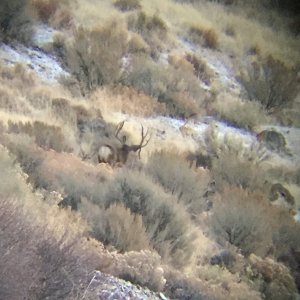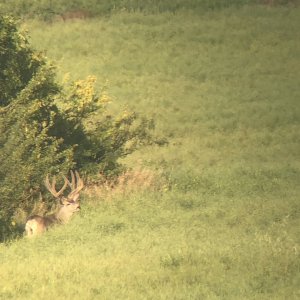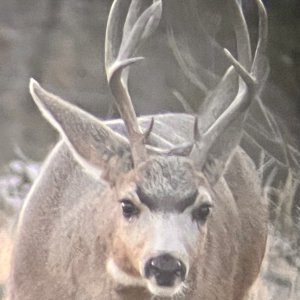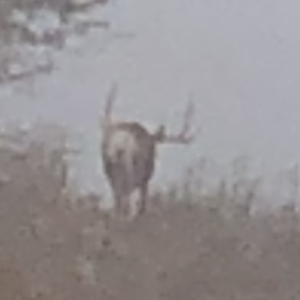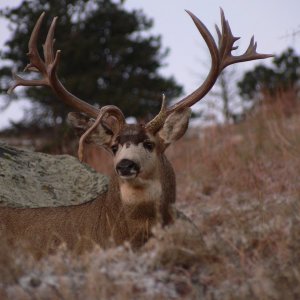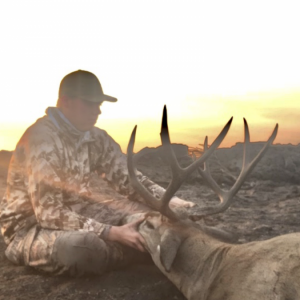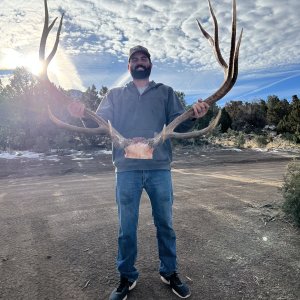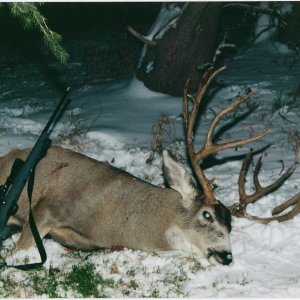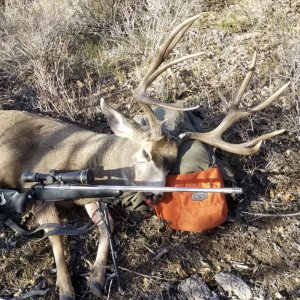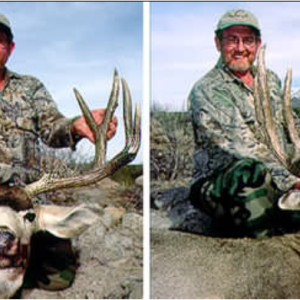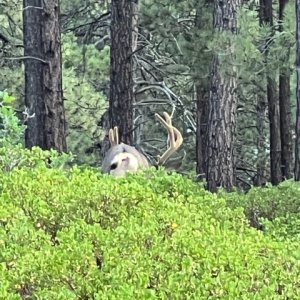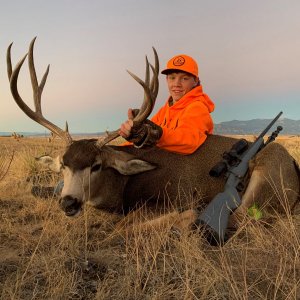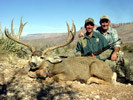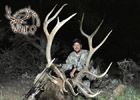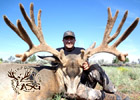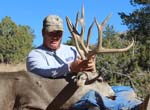LAST EDITED ON Sep-08-08 AT 05:29PM (MST)[p]Quest,
Here's an article I wrote in 2000, when Ray Lee was head of the big-game branch at AZ G&F. Not that he cites the Palmer Index in it. -TONY
Arizona Deer ? Oh, How they thirst
For more than a decade now, Arizona?s deer population has been on the proverbial roller-coaster ride. Sadly, in recent years the downs have been a lot lower than the ups have been high. As a result, the state?s overall mule deer population is currently approaching the lowest it has ever been. Although the Coues deer have done somewhat better, their numbers have also dropped.
This fact became quite evident last spring when the Arizona Game and Fish Department (AGFD) made its recommendations for the fall 2000 hunts. The total allocation for both species approved by the five-member game commission was 45,850 ? the lowest total since the (AGFD) began compiling data in 1946. It was 970 fewer than the 1999 total. And if the rest of this year plays out as it has so far, the permit allocation could fall even more when the commission considers next year?s hunt proposals in April, 2001.
Who can we blame for all this and especially for the loss of deer hunting opportunities?
No one that could make a difference; the game department, you or me can't do a thing to change it. The culprit has been Mother Nature, or more specifically her unwillingness to bestow bountiful rains on the Grand Canyon State for more than one year in a row.
AGFD big-game supervisor Ray Lee?s enthusiasm has followed the same trend as the state?s deer population. After many years of watching the herds steadily decline, Lee happily witnessed the effects of El Nino over the winter of 1997-1998.
?We thought we might have turned the corner in 1999 when fawn recruitment statewide increased considerably. But it was a short-lived jump, and the reason why I had stated back then that hunters shouldn't be too enthusiastic until we have a couple rainy years strung together.?
Lee?s warning proved prophetic.
As it turned out, 1999 was one of the driest years on record in Arizona. The Phoenix metro area went for more than 100 days between September and December without any measurable precipitation. When the rain finally arrived, it wasn?t enough to require the use of windshield wipers. Finally in March, 2000 a big storm hammered the state, dumping more than two inches on Phoenix and even more in other areas. But the two-day deluge overwhelmed the watersheds. The ground couldn't absorb the water quickly enough, and most of it ran downstream into the lakes or Mexico?s Sea of Cortez.
Pointing to the Palmer Drought Severity Index compiled by The National Atmospheric Association, Lee doesn't hold much hope for the very immediate future.
?The Palmer Index examines past and current rainfalls, winds, temperatures and other factors. The most recent chart shows the southwestern United States and more specifically, Arizona, as being in the middle of extreme drought conditions. In other words, even if the entire state received two inches of rain tomorrow, it probably wouldn't take us out of that extreme category because of the moisture we haven't received in previous months.?
The major concern of biologists when it comes to the relationship of rain and deer is timing. Rains that come at the wrong time of the year provide little benefit to big game. In the case of deer, the two key periods to benefit them are late winter and late summer.
Lee points to the 1998 deer population jump as a perfect example of what can happen.
"We had normal winter rains, good spring rains and adequate summer rains. Statewide, fawn recruitment went to nearly 40 fawns per 100 does in areas of the state where it had dropped to as low of 20 fawns per 100 does. On the Kaibab Plateau, somewhat different climatic conditions caused the corresponding recruitment to rise to nearly 90 fawns per 100 does. It was an exceptional year. Unfortunately, it was only one, and that won't do it.?
According to Lee, the lack of moisture to sustain ideal deer populations started in 1988 and pretty much reflects the trend that occurred about 40 years ago.
?Our deer numbers reached the highest ever in the 1960s, but the population dropped very rapidly from those numbers to all-time lows by the late 1970s. That's why we put deer on the permit system in 1972. And if we look back at the weather conditions from the late 1960s and early 1970s. we would quickly see they mirror the same patterns that are occurring right now. The deer population is also following the pattern.?
?Then the deer numbers shot up again in the early and mid-1980s because we had an anomaly of sorts with rains that produced three 100-year floods over a five-year period. Even the normally dry Salt River was running at 200,000 feet per second and washing out bridges in downtown Phoenix.
?The result on our deer herds was quite predictable. For a few years running, all of the does had twins, their twins had twins, and those twins?and so on. So we wound up with more deer than we knew what to do with. Over the next several hunting seasons, we had more permits available than we had hunters to apply for them. In 1986, we set the all-time record with 95,821 permits. That is more than double the permit allocation for 2000.
?The one thing hunters shouldn't do, however, is think we'll ever get to that point again. The floods were very uncommon occurrences that created the best deer habitat we've ever had. So unless those conditions repeat themselves, which isn't too likely, our traditional optimum deer numbers will be considerably less than what we had in 1986.?
Fortunately, even though the permit numbers are at an all-time low right now, there are still more deer today in Arizona than there were in the 1970s when the population hit bottom. The reason is a different management concept put into place by the AGFD.
When the herds plummeted in the 70s, the hunter success did likewise, averaging 16 to 18 percent statewide -- a result of supply and demand with only so many deer to go around. This prompted many complaints from hunters. Rather than allow that trend to continue, the game department began adjusting the permit allocation whereby the hunter success remained fairly consistent at 21 to 24 percent in most units. So while fewer hunters go afield now, more of those that do get to a tag a buck.
The relationships between moisture and deer populations can be somewhat difficult to understand, but what it mostly comes down to is habitat.
The simple explanation: when plants gets rained on they grow and provide moisture, nutrition and cover for deer. And obviously, lots of rain also provides more standing water. The more complicated explanation involves all the interrelationships within the simple one, including what appears to be increased predation.
For the most part, the number of deer and predators are intertwined with each other, with the latter?s population increasing or declining in proportion to that of deer. But the adjustment takes time, according to Lee.
?When the deer herds are large and healthy, the predators are also healthy and numerous. When deer numbers begin dropping, though, the predator numbers stay high for considerably longer. They continue to kill the same number of deer as before. So over time, the percentage of a deer herd killed by predators in any particular area goes up, and that trend continues until the predator numbers drop in relationship to the deer decline.?
?To illustrate, consider a healthy deer population of 100,000 and a predator base of 1,000 that kills 10,000 deer annually. The resulting loss to predation is 10 percent of the deer population, thus cutting the deer herd size to 90,000. If that herd contains 60,000 does that kick out 40 to 50,000 fawns, the loss to predators is considered minimal. Now consider the same predation on the deer if their number falls to 20,000 animals; the loss of 10,000 animals now amounts to 50 percent of the herd and leaves maybe 6,000 does left to drop 3,000 or so fawns. All of a sudden the predation rate is three times the fawn production. This would rapidly cause the demise of that deer herd if the predator population didn't eventually adjust to the deer numbers. Fortunately, it always happens. It just takes time and consequently causes the deer population to recover more slowly.?
?In years of good moisture, deer can normally get all the moisture they need by eating. As the rains decrease, they have to find other sources, which are mostly tanks or other standing water. That walking and use of standing water sources increases the chance for predation and burns up additional energy.?
?Without water and nutrients, a doe doesn't put on weight, and the chances for her to drop twins go down considerably. She also has a lower milk production when she does drop a fawn, and the lack of good cover makes the survival of that fawn more iffy because of predation. And we're not talking a lot of weight to make a difference. If a doe can increase her weight by 5 percent, it's likely her fawn will weigh a pound more when born. That is significant for the survival of a fawn that weighs five or six pounds at birth.?
Another consequence of the recent droughts years have been forest fires. Earlier this year, at least three major ones devastated large portions of Arizona?s landscape. The highly extreme conditions for more fires prompted the U.S. Forest Service to shut down any access to large portions of several national forests in the state.
Lee feels the forest fires come under that ol? good news/bad news syndrome, though.
?Even though a lot of Arizona burned up this year, by and large forest fires are good for the habitat. It's a case of looking at fires over both the short term and the long term. At first, the effect is not too good because those areas basically are sterile. All the growth that deer might utilize this fall is gone. But Mother Nature does wonderful things to compensate.?
?Once we start getting some moisture in those areas, the nutrients begin going back into the soil, and all sorts of fresh browse sprouts. Deer don't eat pine trees, but they relish these tender forbs. So in the long run, the fires can be a blessing for our deer herds. Again, though, the key factor in the equation is rainfall. If we don't get rainfall on those burned out areas this winter, the likelihood of them greening up next spring is fairly remote.?
?The burned out areas are certainly a concern, but right now even the habitat where fires haven't taken a toll are being stressed. Perennial plants such as cliffrose, which is a key food source for deer, can exist a long time with low moisture from year to year, but eventually that lack of moisture will kill off individual plants. You can only stress plants so many times until they become decadent. Although this hasn't happened to any great level across the state yet, some of our range people do view it as a potential problem. For the most part, habitat is fairly resilient and will eventually recover as it always seems to do. Moisture and time are the only requirements.?
The condition of the habitat isn't the only thing that bothers Lee, however.
?What concerns me more is a lack of habitat for the future. We?re losing it fast as more and more people move into Arizona and especially into the places that have been traditionally good deer areas. Just look all around Phoenix, where even the desert areas within a 50-mile radius once harbored decent deer numbers. Now many of them are covered with houses and shopping malls. The same thing is occurring around Prescott, Payson, Tucson, Flagstaff or even in the White Mountains, where more and developments of ranchettes and such are springing up. Mule deer simply won't strive in subdivisions even if the residents plant acres and acres of succulent landscaping. So even if we get several years in a row of good rainfall at the right times, we might never reach the high deer populations of the past because there will be fewer places for deer to live.?
While the future appears filled with doom and gloom for Arizona?s deer, in reality it could turn around quickly. In fact, even now there are places in the state where the herds are thriving and even growing somewhat, despite the so-so habitat conditions.
One such place is the North Kaibab Plateau. Several years ago, a huge fire wiped out a large portion of the winter habitat on the west side. What remained has been in good shape for the most part, so the deer have done well. Still, the game department has continually managed the deer there to keep them in check.
Lee feels the deer on the Kaibab are healthy.
?The forage is in good shape but limited right now in that it will support only so many deer. We?ve attempted to keep the numbers down in such a way where the herd will rebound as the burned-out area comes back. That's why we're still issuing doe permits there. If we can hold the population down to the point where it won't destroy the good habitat that now exists, we'll never have to have a drastic cut on the deer numbers there.?
Another area where the deer have done fairly well is the far western edge of the state from Kingman on down to Yuma where rainfall has been significantly better over the last two years. The result was a slight increase in deer permits for the 2000 hunts.
Coues deer have also fared a bit better, according to Lee.
?We had been cutting back on mule deer permits for the past 10 years or so but didn't start making noticeable cuts in whitetail permits until the last couple of years. This is mainly due to the way Coues deer live in comparison to mule deer.?
?The mule deer tend to be in larger groups. So they need more water and forage. Whitetails move in smaller groups and stay at the higher elevations where the moisture has been more prevalent. Plus, whitetails are what I like to term as a ?bushier? animal; they wander over smaller areas and use dense cover a lot more than mule deer do. The result is a lesser need for water. They get much of it from the vegetation they eat as long as the moisture content is sufficient.?
At one time, Arizona?s mule deer numbered somewhere between 250,000 to 300,000. Today, there are about 100,000, while the optimum goal for the available habitat is now about 200,000.
Lee feels that goal is easily attainable.
?It won't take much. We'll need some back to back years of good rainfall. Two would do it, but three would be even better. It can't be an ?every other one? deal. If we have successive years with good moisture, most of the does will drop twins, and during the next year, the yearlings will go into estrous and get serviced by a buck because they will have gained a lot more weight than they would have during a low-moisture year. In all likelihood that yearling will have a single fawn, but one is better than none.?
?I certainly can't predict this will happen in the immediate future. Yet if and when it does, we could again be enjoying the glory years of plenty of deer to go around. All we need is for Mother Nature to quench the thirst of our deer herds.?
COPYRIGHT BY TONY MANDILE

